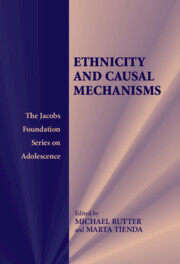Book contents
- Frontmatter
- Contents
- List of Contributors
- Foreword
- Preface
- 1 Natural Experiments, Causal Influences, and Policy Development
- 2 Growing Up Ethnic in the United Kingdom and the United States: Comparative Contexts for Youth Development
- 3 The Multiple Facets of Ethnicity
- 4 Educational Attainments: Ethnic Differences in the United Kingdom
- 5 Race and Ethnic Inequality in Educational Attainment in the United States
- 6 Racial and Ethnic Disparities in Crime and Delinquency in the United States
- 7 Explaining Ethnic Variations in Crime and Antisocial Behavior in the United Kingdom
- 8 Cultural Differences in the Effects of Physical Punishment
- 9 Ethnicity and Mental Health: The Example of Schizophrenia in the African-Caribbean Population in Europe
- 10 Ethnic Variations in Youth Suicide
- 11 Ethnicity and Intergenerational Identities and Adaptations in Britain: The Socio-Political Context
- 12 Assimilation, Dissimilation, and Ethnic Identities: The Experience of Children of Immigrants in the United States
- 13 Deciphering Ethnicity: Reflections on Research Opportunities
- Author Index
- Subject Index
11 - Ethnicity and Intergenerational Identities and Adaptations in Britain: The Socio-Political Context
Published online by Cambridge University Press: 05 July 2014
- Frontmatter
- Contents
- List of Contributors
- Foreword
- Preface
- 1 Natural Experiments, Causal Influences, and Policy Development
- 2 Growing Up Ethnic in the United Kingdom and the United States: Comparative Contexts for Youth Development
- 3 The Multiple Facets of Ethnicity
- 4 Educational Attainments: Ethnic Differences in the United Kingdom
- 5 Race and Ethnic Inequality in Educational Attainment in the United States
- 6 Racial and Ethnic Disparities in Crime and Delinquency in the United States
- 7 Explaining Ethnic Variations in Crime and Antisocial Behavior in the United Kingdom
- 8 Cultural Differences in the Effects of Physical Punishment
- 9 Ethnicity and Mental Health: The Example of Schizophrenia in the African-Caribbean Population in Europe
- 10 Ethnic Variations in Youth Suicide
- 11 Ethnicity and Intergenerational Identities and Adaptations in Britain: The Socio-Political Context
- 12 Assimilation, Dissimilation, and Ethnic Identities: The Experience of Children of Immigrants in the United States
- 13 Deciphering Ethnicity: Reflections on Research Opportunities
- Author Index
- Subject Index
Summary
Exclusion and Inclusion
Ethnic identities as publicly projected self-concepts have proved to be unexpectedly popular in Britain among members of ethnic minorities, especially compared to earlier migrant groups and their descendants, say, Jews from eastern Europe. Minority groups have played a major role in determining the public character of these identities, as well as in relation to the prevalence and decline of specific labels. A key feature of these self-concepts has been their politically oppositional character. This was less salient initially – when one might have expected migrants to have had a greater sense of “otherness” – and became more prominent as migrants became more settled and a new generation reached adulthood. Oppositional stances increased as interaction with mainstream British society and policy participation rose, when one would have expected, if not assimilation, a softening of ethnic identities.
The explanation of this paradox begins with racism: Non-Whites were perceived and treated as racially defined groups of inferiors, outsiders, and competitors whose right to be in Britain and to be treated as equal citizens was not fully accepted. That they were marked out as “racial” groups and understood as racialized ethnicities has three implications (Modood, Berthoud, & Nazroo, 2002). First, migrants were perceived as a collectivity or more precisely as collectivities rather than merely as individuals, neighbors, fellow-workers, citizens, and so on.
- Type
- Chapter
- Information
- Ethnicity and Causal Mechanisms , pp. 281 - 300Publisher: Cambridge University PressPrint publication year: 2005
- 13
- Cited by



